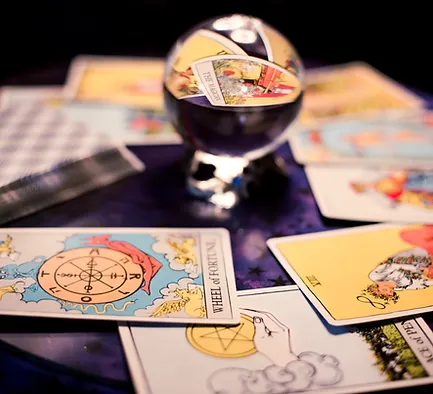
You can unveil the future in the most amazing way through oracle readings! They convey a message of hope and should help you reduce your worries and dispel any doubt you may have in your day-to-day activities. The 53 cards in the Tarot and Oracle are intended to guide you into the world of Mage Edmond and provide insight into your personal journey through life.
The art of tarot reading involves using a particular spread (or layout) of Tarot cards to intuit knowledge and direction. Contrary to common assumption, Tarot readings are not just fortune-telling exercises, and one need not be a psychic to do them. The goal of the cards is to give you insight into the deepest truths of your higher self. In other words, the cards help you become more conscious of what you already know deep inside.
Tarot Began as playing cards and have their roots in Ancient Egypt, when the “book of Tot” served as their inspiration. Pages of pure gold papyrus containing the vast body of human knowledge were given to his people by Tot, also known as Thoth, the Egyptian god of wisdom.
At their most basic level, tarot cards are a traditionally organised deck. When it comes to Tarot, there are a few more guidelines than there are for Oracle cards. Oracle cards can include nearly any type of content because they are so open-ended. There are typically 78 cards in a deck of tarot cards. Some decks enjoy being distinctive and a little unique. In the end, you might have 80 cards or 44 cards, but 78 cards are the norm. Contrarily, there is no predetermined quantity of Oracle cards. A deck can include 12, 100, or any other number of cards.
Tarot cards have a conventional deck design and accepted interpretations. The majority of decks are variations of the Rider-Waite format, and they all have similar themes. Even though the graphics and the visuals could be completely different, the messaging behind the card is frequently fairly same. As a result, although Oracle cards lack a common subject, Tarot cards generally have one that unifies all of the cards.
The solutions you’re looking for are already in your subconscious. You can gain access to your subconscious using the runes. Find a quiet time and location where you won’t be disturbed to peruse the runes. Take a few slow, deep breaths, relax, and focus solely on the question you want to ask. Closing the curtains, lighting a candle, and/or an incense stick are optional but can help you make the most of the occasion. Select the desired cast from the list below.
Rune is a type of divination or oracle reading technique that is intended to assist shed light on circumstances or inquiries. The word “rune” simply means mystery, whisper, or secret. Although runes can be constructed of many different materials, they are most frequently formed of stone and have a runic alphabet symbol on them.
The old Germanic runic alphabet known as “Elder Futhark” is one of the oldest runic alphabets still in use today. There are many different kinds of runic alphabets that are utilised on runes. The first six runes of the Elder Futhark’s 24 runes spell out the word “futhark.”
Again, taken from Egypt The Sun and the Nile, which provided them with nourishment and subsistence, as well as domestic and wild animals, all had symbolic implications for the ancient Egyptians. Even the architecture of the species linked with funeral rites was replete with nuanced, evocative meanings.
At its most profound, symbolism served as a means for the Egyptians to express their thoughts on life itself, nature, the conflict between good and evil, and afterlife.
Ancient Egyptian writing was extremely symbolic and closely related to the gods; the fact that one word was used to describe both drawing and writing is evidence of how closely related these two actions were.
Tea leaf reading is the art of interpreting future omens from the tea leaves. Both sceptics and believers have voiced their opinions on the tradition of seeing symbols or flashes of divination in tea leaves.
People were frequently asked to predict the future in ancient cultures. There was an Oracle in Egypt, a Delphi in Greece, and pagans, soothsayers, alchemists, and itinerant gipsies would all appear centuries later. Each of these spirit-filled individuals would channel their capacity for foresight through a variety of items. Some would use crystals or rocks, some would use roots and herbs, and eventually some would utilise tea.
In a tea leaf reading, dried tea leaves are tossed carelessly into a teapot with boiling water, then the tea is brewed and put straight into cups without the need of a strainer. The individual who is interested in learning about their future then drinks the tea. In certain rituals, the seeker turns the cup clockwise while holding it in the palm of their hand. It is not too difficult to take the tea at first taste.
The tea will be easier to drink without swallowing the leaves as it nears the bottom of the cup. The majority of tea drinkers will use their remaining liquid to swirl, while others will stop short of the finish line, leaving little amounts of tea behind. The seeker will hand the cup to a reader after determining that they are done. The majority of those who read tea leaves advise against doing so.